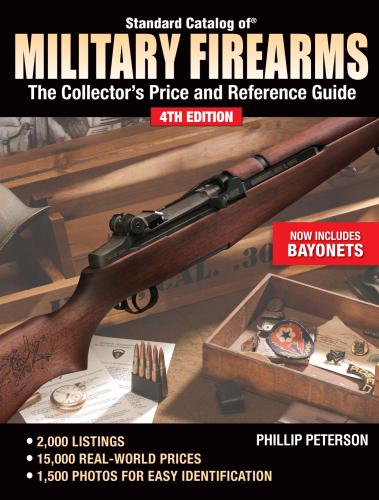M1954 Caliber .30-06 Short Rifle
This model was also built in Brazil and chambered for the .30-06 cartridge. Fitted with a 23.25" barrel. Tangent rear sight graduated to 2,000 meters. Pistol grip stock with finger grooves. Nose cap fitted with a bayonet lug. Weight is about 8.75 lbs. Brazilian crest on receiver ring.
MACHINE GUNS
The Brazilian military uses a wide variety of machine guns. They are: the FN MAG, Browning M1919A4, the Browning .50 M2 HB, the Danish Madsen converted to .30 caliber, and even the Hotchkiss LMG in 7mm. The Brazilian military has also developed, in the 1990s, its own design called the Uirapuru GPMG in 7.62x51mm.
Bayonet for Brazilian Mauser
CANADA
Canadian Military Conflicts, 1870-Present
In 1867, under the British North America Act, the Dominion of Canada was created. In 1982 the British Parliament in London gave Canada’s constitution full self control. Because Canada has such close ties to Great Britain, much of Canada’s military history closely follows Great Britain, especially during both World Wars and Vietnam.
HANDGUNS
INGLIS, JOHN & COMPANY
Introduction by Clive M. Law
This firm manufactured Browning Pattern .35 semi-automatic pistols for the Canadian, Chinese, and British governments. Pistols are parkerized dark gray and include black plastic grips and a lanyard ring. Premium paid for pistols which still display the Canadian “Lend-Lease” decal on the front grip strap. Fewer than 160,000 pistols were manufactured between 1943 and 1945. Add $350 for original Canadian-produced wood stocks. Prices shown here are for original finish unaltered pistols, prices lower for recent Chinese and British imports.
Courtesy Richard M. Kumor Sr.
Mk. 1 No. 1 (Chinese Marked)
The first 4,000 pistols destined for the Chinese government included a six character Chinese marking on the slide, as well as a serial number which incorporated the letters “CH.” Includes a tangent rear sight and a stock slot.
Mk. 1 No. 1
Identical to the Chinese-marked model but without the Chinese characters.
Mk. 1 No. 1*
Externally identical to the No. 1 Mk. 1 but the slide includes the marking Mk. 1*. This mark may be factory applied, or applied in the field after conversion.
Inglis slides from top to bottom: Chinese pattern No. 1 Mk.1, Canadian forces No. 2 Mk.1, later Chinese-type No. 1 Mk. 1* • Courtesy Blake Stevens, The Browning High-Power, Stevens
No. 2 Mk. 1
The first 10,000 pistols made for Canada/Britain display the standard slide legend, fixed rear sight in the distinctive Inglis “hump,” and no stock slot. All No. 2 type pistols will incorporate the letter “T” within the serial number.
No. 2 Mk. 1*
Identical to the No. 2 Mk. 1 externally but the slide includes the marking Mk. 1*. This mark may be factory applied, or applied in the field after conversion. Some examples imported from England or New Zealand may include the “No. 2” stamped or engraved on the slide.
Paul Goodwin photo
No. 2 Mk. 1* Slotted
A small quantity of pistols, mostly in the 3Txxx range, were made up from Chinese frames and include the stock slot. Beware of fakes.
DP Pistols
Approximately 150 No. 1 type pistols, some with the Chinese inscription, were made up as display and presentation pistols. Serial numbers will range from approximately DP1 to DP150.
Inglis Diamond
In the last week of production, Inglis marked a small quantity of pistols with their trademark, the word Inglis within a diamond. Both the No. 1 and No. 2-style pistols were so marked. Some pistols remained in the white while others were parkerized. It is believed that fewer than 50 pistols were marked.
New Zealand Issue
Only 500 pistols were acquired by New Zealand in the 1960s. A small quantity was modified and marked by the NZ Special Air Service.
British Issue
A large quantity of pistols have been imported from the British Ministry of Defense over the past several years. These pistols often display a black “paint” finish and may be marked “FTR” (Factory Thorough Repair) or “AF” (meaning unknown).
Dutch Issue
The Netherlands used over 10,000 Inglis pistols. Early versions display a small crown over W mark on the rear sight while later models will have Dutch serial numbers, Belgian proofs, and Belgian barrels.
Belgian Issue
Belgium received 1,578 pistols as aid from Canada in the 1950s. These remained in use with the Gendarmerie until recently. Some pistols will display a gray “paint” finish and have numbered magazines. These have been wrongly identified as Danish navy in the past.
